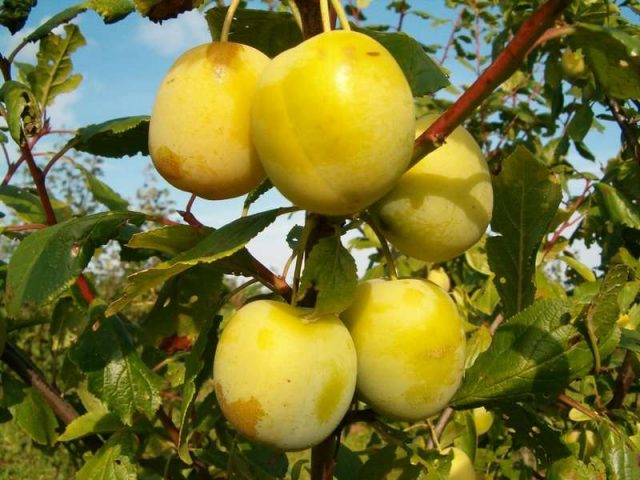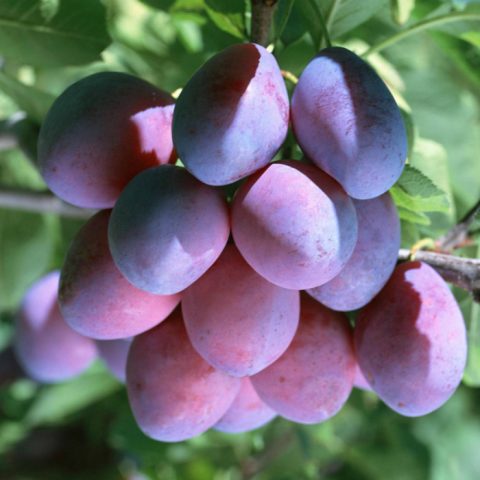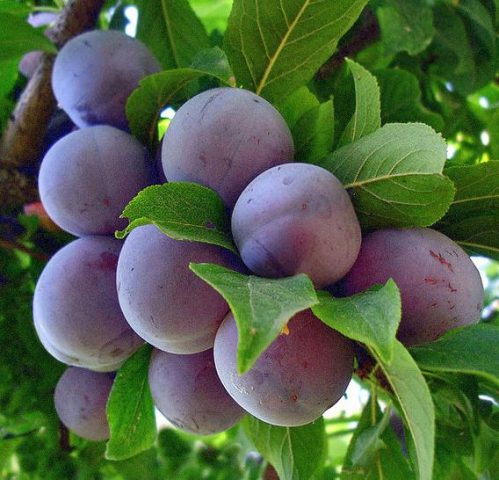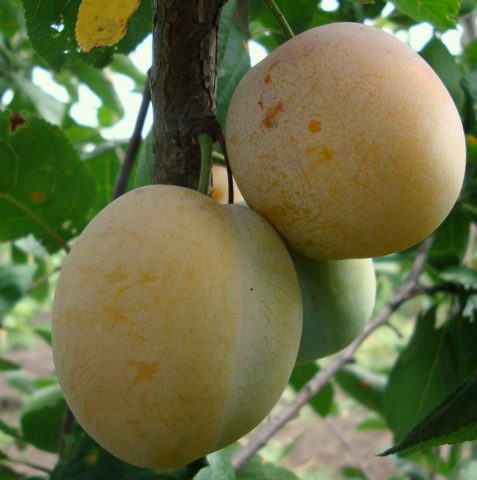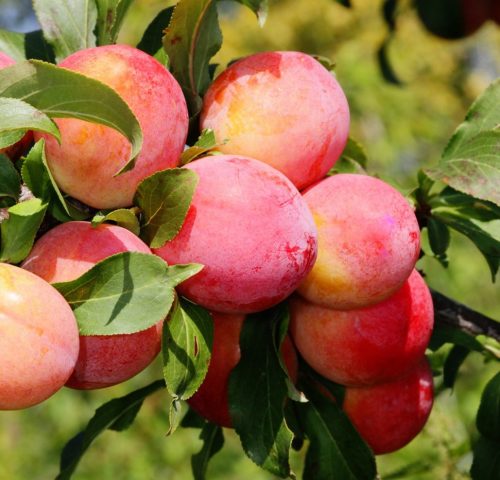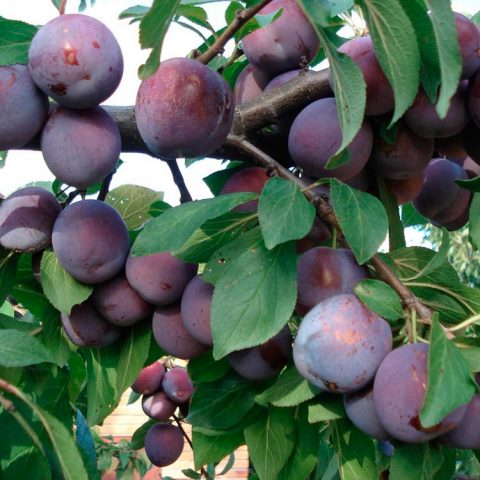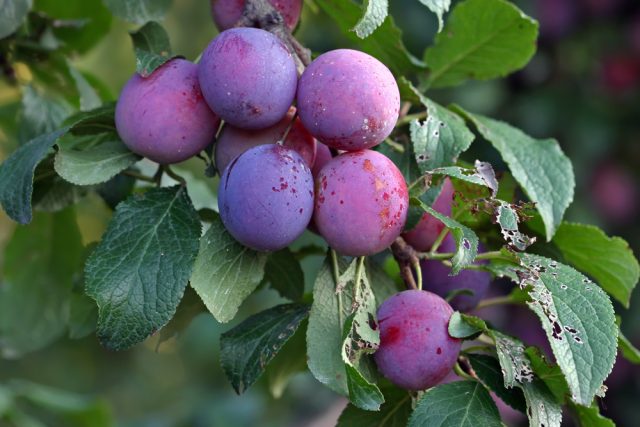Content
- 1 Breeding history of the variety
- 2 Description of the variety
- 2.1 Renclaude Altana
- 2.2 White
- 2.3 Beauvais
- 2.4 Enikeeva
- 2.5 Renclode Yellow
- 2.6 Renclaude Green
- 2.7 Renklod Karbyshev
- 2.8 Renklode Kolkhozny
- 2.9 Red
- 2.10 Kuibyshevsky
- 2.11 Kursakova
- 2.12 Leah
- 2.13 Renklode Michurinsky
- 2.14 Opal
- 2.15 Presidential
- 2.16 Renclaude Early
- 2.17 Reform
- 2.18 Renclaude Pink
- 2.19 Renclaude Blue
- 2.20 Renklode Soviet
- 2.21 Renklode Tambovsky
- 2.22 Tenkovsky (Tatar)
- 2.23 Shcherbinsky
- 3 Variety characteristics
- 4 Landing features
- 5 Plum follow-up care
- 6 Conclusion
- 7 Testimonials
The Renclode plum is a famous family of fruit trees. Subspecies of the variety have excellent taste. Their versatility makes the plant available for growing in a variety of climatic conditions.
Breeding history of the variety
The history of the plum tree begins in the 16th century in France. It was bred on the basis of the Verdicchio variety. The name Renclaude was given in honor of the daughter of Louis XII - Queen Claude.
Description of the variety
The Renclode plum is widespread in many countries, regions with different climates:
- Russia;
- Ukraine;
- Belarus;
- France;
- Italy;
- Germany, others.
The variety includes a large number of varieties. They are united by common signs, features:
- The average height of the trees is 4-6 m.
- Branches of a red-brown hue turn gray after a while.
- Leaves with veins, light hairiness.
- The crown of the plum is spherical.
- Round fruits grow up to 4-5 cm. Each subspecies has a different color - from light green to dark purple. The taste of dessert plums is sweet.
Renclaude Altana
The history of the variety begins in the Czech Republic in the 19th century. It appeared thanks to a self-mutation from the bones of Renclaude the Green. The main characteristics of the subspecies:
- The height of the plum is 6.5 m. The crown is spherical.
- Large fruits. Weight of one - up to 40-45 g. Plum of light green hue, pulp - amber. The fruit is juicy and sweet.
- It can grow on any soil.
- The variety grows rapidly.
- Resistant to drought, frost.
- Altana is a self-fertile variety. To improve fruiting, Mirabelle Nancy, Victoria, Renclode Green, Hungarian Domashnaya are planted nearby.
- First fruiting after 3 years. One plum brings about 30 kg of fruit. An adult tree increases this figure to 80 kg.
White
The dull white color of the fruit is a distinctive feature of the White plum variety. The exotic shade does not affect the taste of the fruit. They are sweet, juicy. The weight of one plum is 40-45 g. Fruits in the third year of life. The tree reaches 4-4.5 m in height. The variety is resistant to arid climate, frost.
Most often, fruits are eaten fresh. Canned white plums have an unaesthetic appearance.
Beauvais
The species prefers a warm climate. Most often found in the Krasnodar Territory, in the North Caucasus. The Bove variety has characteristic features that distinguish it from other subspecies:
- Plum - medium in height. The branches grow quickly, chaotically. The crown is not thick.
- Self-fertile variety with large, sweet fruits. Beauvais plums have a yellow-green hue, a purple spot on the side.
- Fruit ripening occurs by September.
- The variety gives a bountiful harvest - from 50 to 100 kg of fruits in one season.
Beauvais plums are well transported. Keep their presentation up to two weeks.
Enikeeva
The Enikeeva variety is an excellent option for a small area. Fruit ripening begins in mid-August. Bears fruit with medium-sized purple fruits. Plum weight - up to 25 g. One tree accounts for up to 10-15 kg of harvest.
The subspecies is resistant to droughts, frost, and pests. It is self-fertile and does not need pollinators.
Renclode Yellow
Renclaude Yellow is characterized by rapid growth. Plum reaches 6 m in height. Ripening occurs by late summer - early autumn. Fruits are small, rounded, slightly flattened on the sides. Fruit pulp is green with yellow. The taste of plums is sweet. The fruits can be transported over long distances. They are not deformed and retain their taste.
Renclaude Green
Variety Zeleny is the ancestor of the rest of the subspecies of the Renclode group. Plum is resistant to drought and frost. Can be grown in southern and northern regions. It is undemanding to the composition of the soil. Excessive moisture can negatively affect the health of the tree. Moderate watering should be done.
Plum Renklode Green grows up to 7 m. Its crown is spreading, wide. She prefers spaciousness, abundant lighting.
The first fruiting occurs after 5 years. The first fruits ripen in August. The yield is gradually increasing from 30 to 50 kg.
Fruits are small - up to 20 g. Yellow-green fruits are very juicy and sweet. The pulp appears to be translucent.
The variety is resistant to diseases and harmful insects. Preventive measures exclude the possibility of destroying the plum through their fault.
Renklod Karbyshev
The history of the subspecies begins in 1950 in Ukraine. The variety is characterized by fast growth. Regular pruning of branches is required to form the crown.
Plum Karbysheva prefers warmth. It is severely damaged at low temperatures. The fruits of the first harvest weigh up to 50 g. Then they gradually decrease to 35 g. Dark purple fruits with amber pulp are considered dessert fruits. They are highly appreciated by experienced gardeners.
The variety needs additional pollinators among other Renclode subspecies:
- Early;
- Green.
Renklode Kolkhozny
The Kolkhozny variety was bred by Michurin I.V. in the 19th century.It has inherent features that distinguish it from other varieties:
- Plum can withstand low temperatures. Can be cultivated in southern and northern regions.
- The tree reaches 3 m in height. The crown is spherical, slightly flattened.
- Fruit ripens in mid-August. The yield is annual, abundant. Up to 40 kg of fruit are harvested from one plum.
- Yellow-green fruits weigh up to 20 g. Sweet and sour pulp is juicy, sweet.
- The subspecies is not resistant to disease. It is recommended to carefully, regularly carry out preventive measures.
To improve the quality of fruits, increase yields, pollinator varieties are planted nearby:
- Red Skorospelka;
- Renklode of Thorns;
- Hungarian Pulkovskaya.
Red
Skorospelka Krasnaya variety is a medium-sized plum. Its crown is wide, oval in shape. Blooms in mid-May. The end of August is the fruiting period. Dark red elongated plums weigh up to 15 g. First harvest in 4 years.
The variety is partially self-fertile. He needs pollinators:
- Renklode Kolkhoz;
- The Golden Fleece;
- Hungarian Pulkovskaya.
Adult shoots are more resistant to frost.
Kuibyshevsky
In the 50s of the last century, the Kuibyshevsky variety was bred specifically for the northern regions. The plum is frost-resistant. It reaches 6 m in height. The crown of the subspecies is spreading, dense. Round fruits of a light green color with spots. Weight of one - 25 g. Harvested in August. A young tree brings 6-8 kg, an adult - 20-30 kg.
Important! Ripe plums hang on the tree for up to seven days. They must be removed in a timely manner to avoid damage.
Kursakova
The fruits of the Kursakova variety are red with a purple tint. They are very soft, juicy, sweet. The plum is barren. She needs additional pollinators. They can be other subspecies of Renclaude.With good care, careful shelter for the winter, the plant survives severe frosts without damage.
Leah
The Liya variety prefers a warm climate. The plant is resistant to disease. First harvest in 3 years. The yellow fruits are not large. One plum weighs up to 12 g. Fruit is harvested at the end of August. The Leah variety is stored for a long time - up to 25 days.
Renklode Michurinsky
The Michurinsky variety is quite young. It was taken out at the beginning of the 21st century. The trunk is low with a spherical crown. The dark purple fruit is harvested in September. The weight of one fruit is 25 g. The plum gives 20-25 kg of yield.
The variety is characterized by high frost resistance. It can be transported over long distances without damaging the drain. A self-fertile subspecies, with additional pollinators, will give a more bountiful harvest.
Opal
The Opal variety is characterized by high early maturity, dessert taste of plums. A tree with a round crown grows up to 3 m. It is easy to shape by pruning. After 3-4 years, the first crop is harvested.
Blooms in mid-May. The cultivar is not completely self-fertile. For a bountiful harvest, it needs pollinators. Fruits are round, small, dark purple with a yellow-green spot on the side. Ripen in the middle of summer. One plum in a good year gives up to 20 kg of fruit.
Presidential
Renclaude Presidential grows up to 4 m. The crown resembles an inverted fan. Plums ripen in autumn. The weight of one is 55-60 g. Purple fruits with a yellow heart. The taste is sweet with sourness. The harvest of the subspecies is abundant. Its volume increases over the years. It is resistant to low temperatures, but is exposed to many diseases and pests.
Renclaude Early
The history of the Early variety begins in Ukraine in the second half of the 20th century. An important feature is that fruiting occurs earlier than others. The first ripe fruits are harvested in July.
Plum is frost-resistant, tolerates dry periods. It grows up to 6 m. Its crown is spreading. Shoots grow quickly. They need regular pruning.
The yield of the variety is average. The fruits of young plantings are large. The weight of one plum is up to 50 g. Round yellow-green fruits. The side seam is noticeable. One half of the plum is larger than the other.
For a bountiful harvest, additional pollinators are needed:
- Hungarian Donetskaya Early;
- Renklod Karbyshev.
Reform
The Reform variety is a thermophilic plum. She needs careful care, fertile soil, an abundance of light, protection from wind and drafts. Height - up to 6 m. Crohn's rare, branches grow chaotically. The yield is not high - 8-10 kg. The fruits ripen in August-September. Round fruits with a yellow-green hue. One plum weighs 20-25 g.
Renclaude Pink
Variety Pink gives abundant fruiting, resistant to severe frosts. The first crop brings in 3-4 years. Fruits are pink in color with a purple tint. One plum weighs 25 g. The pulp is yellow with a green tint. The taste is sweet. The fruits ripen at the end of August. Fruits are stored for up to 20 days.
Renclaude Blue
Variety Blue is frost-resistant. A characteristic feature is a high immunity to diseases, insect harm.
The plum bears fruit after 3 years. The weight of one fruit is 35 g. They grow tightly to each other. Dark blue oval plums. The taste is sweet, with a slight sourness.
Renklode Soviet
Renklode Sovetsky is a popular plum variety. Its many advantages make it more in demand than other horticultural crops:
- Fast-growing. First harvest in 3 years. Fruiting is regular. A young tree bears up to 15 kg of fruits. More adults - up to 40 kg.
- High resistance to frost. Withstands extremely low temperatures.
- The height of the plum is 3 m. The crown is rare. This improves light access.
- Fruits are spherical. The color is blue. The weight of one plum is up to 40 g. The fruit is very sweet, with a slight sour note.
Renklode Tambovsky
The variety is widespread in Central Russia. The low plum has a spreading wide crown. The subspecies tolerates cold well. The fruits are small. Weight of one - up to 20 g. Elongated shape, color - purple.Golden flesh is sweet and sour.
Three years later, the first crop is harvested. Plums are fully ripe by September. One tree gives 15-25 kg of plums. The variety is self-fertile. Pollinators are needed for abundant fruiting.
Tenkovsky (Tatar)
The Tenkovsky variety has an average level of resistance to frost, pests, diseases, and drought. Grows up to 3 m in height. The crown is thick. Fruiting occurs 3 years after planting.
Shcherbinsky
The Renclode Shcherbinsky variety is self-fertile. Brings an annual harvest of deep blue sweet fruits. Up to 20 kg of fruit can be harvested from one tree.
Variety characteristics
Distinctive features of the Renclode variety are the basis for organizing plant care.
Drought resistance, frost resistance
The variety is resistant to hot climates, temperature extremes. With additional insulation, it can winter in the northern regions of Russia.
Plum pollinators Renclode
The flowering period of the Renklod variety is different for each subspecies. The average flowering period is May-June. Individual varieties do not require additional pollination for a bountiful harvest. Self-fertile varieties include:
- Altana;
- Renclaude de Beauvais;
- Enikeeva, others.
Many subspecies require pollination to increase fruiting. Renklod Kolkhozny prefers nearby Krasnaya Skorospelka, Renklod Ternovy, Hungerka Pulkovskaya. The subspecies Soviet is perfectly pollinated by similar Renklods. To improve fruiting, next to the Altana variety, Mirabel Nancy, Victoria, Green Renklod, and Hungarian Domashnaya are located.
Productivity, fruiting
Renclode is popular with gardeners for its bountiful annual harvests. The number of plums harvested from the tree increases with the age of the plant. Renklode fruits are sweet, sometimes sourness is present. The size depends on the subspecies, the correct care. Fruiting occurs in the second half of summer. Late varieties yield in early autumn.
Scope of berries
Dessert fruits of the variety are perfect for cooking preserves, jams, compotes. Fresh plums are a wonderful summer dessert.
Disease and pest resistance
Trees of the Renclode variety are highly resistant to the influence of insect pests and the manifestation of diseases. Regular preventive measures minimize the risk of such occurrences.
Advantages and disadvantages of the variety
The Renclode variety has undeniable advantages over other horticultural crops:
- Bountiful annual harvest.
- Unpretentious care.
- Delicious large fruits.
- Disease resistance.
- Ability to withstand low temperatures, drought.
Plum does not like drafts, winds. The site must be well protected.
Landing features
Planting the Renclode variety is an important component of proper tree care.
Recommended timing
It is recommended to plant seedlings of subspecies of the Renclode variety in the spring.
Choosing the right place
There are a number of factors to consider when choosing a suitable location in your garden:
- The soil should be loose, fertile.
- The tree prefers an abundance of sun.
- High groundwater levels should be avoided.
- The place should be located on a hill.
What crops can and cannot be planted nearby
The Renclode variety needs pollinating trees for a bountiful harvest. Similar subspecies perfectly cope with this task. They are recommended to be planted next to each other. It is not advised to place plantings of cherry plum, Chinese plum, blackthorn next to it.
Selection and preparation of planting material
Planting material must be prepared in advance. A standard garden tool kit includes:
- shovel;
- rake for loosening;
- stakes, rope for securing the seedling;
- fertilizers;
- water.
Landing algorithm
The procedure for planting Renclode cuttings begins in the fall. The algorithm is quite simple:
- The seedling holes are prepared in the fall. Depth not less than 60 cm.Diameter - more than 70 cm.
- Preparing the soil mixture. The soil from the pit is mixed with humus, potassium.
- Two pegs are lowered into the pit.
- A stalk is installed next to it. Its roots should be 5 cm from the bottom of the pit. Sprinkle with earth, tamp.
- A young tree is tied to stakes with a soft rope.
- Water each planting abundantly.
Plum follow-up care
Plum Renclode is an unpretentious plant. Caring for him does not require a lot of time, material costs:
- Watering. Renclaude does not like excessive moisture. It is recommended to water regularly, but in moderation.
- Fertilizer. Plant feeding begins 3 years after planting. Before flowering, saltpeter, potash salt, mineral fertilizers are poured into the soil next to the tree. During flowering, plums are fed with urea. After flowering, a solution of mullein, superphosphate is added to the tree.
- Pruning. The procedure is performed before the appearance of the first foliage and at the beginning of June.
- Preparing for winter. Young seedlings are covered with spruce branches and needles. It is enough to whitewash mature trees, cover the roots with sawdust.
- Disease prevention, pests.
Diseases and pests, methods of control and prevention
Disease / pest | Control methods / Prevention |
Plum moth | As methods of control, spraying with a solution of "Karbofos" is used, treated with a coniferous concentrate |
Plum aphid | Every April, the treetops are washed with soapy water. |
Plum moth | To destroy this pest, use the drug "Chlorophos" |
Conclusion
The Renclode plum is a famous fruit tree. The variety includes a wide variety of subspecies. Each variety is unique due to its distinctive features. The versatile variety is very popular among gardeners from different regions.

